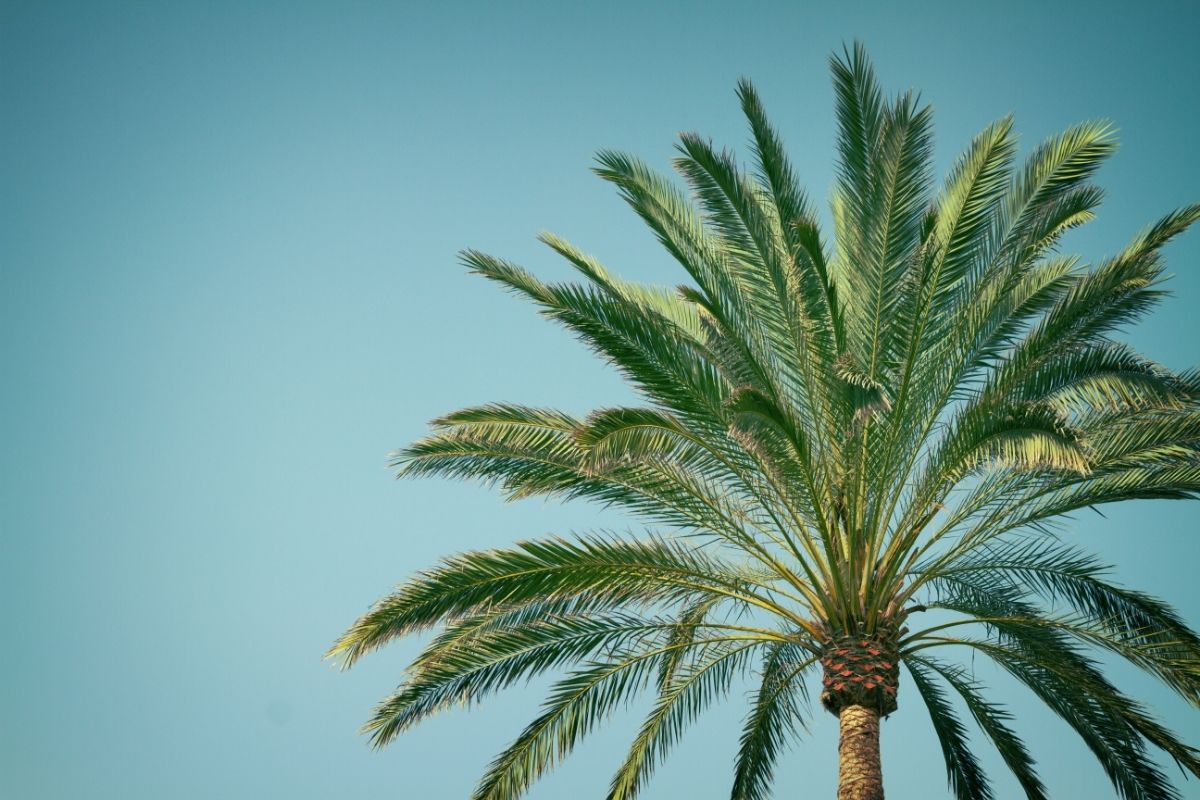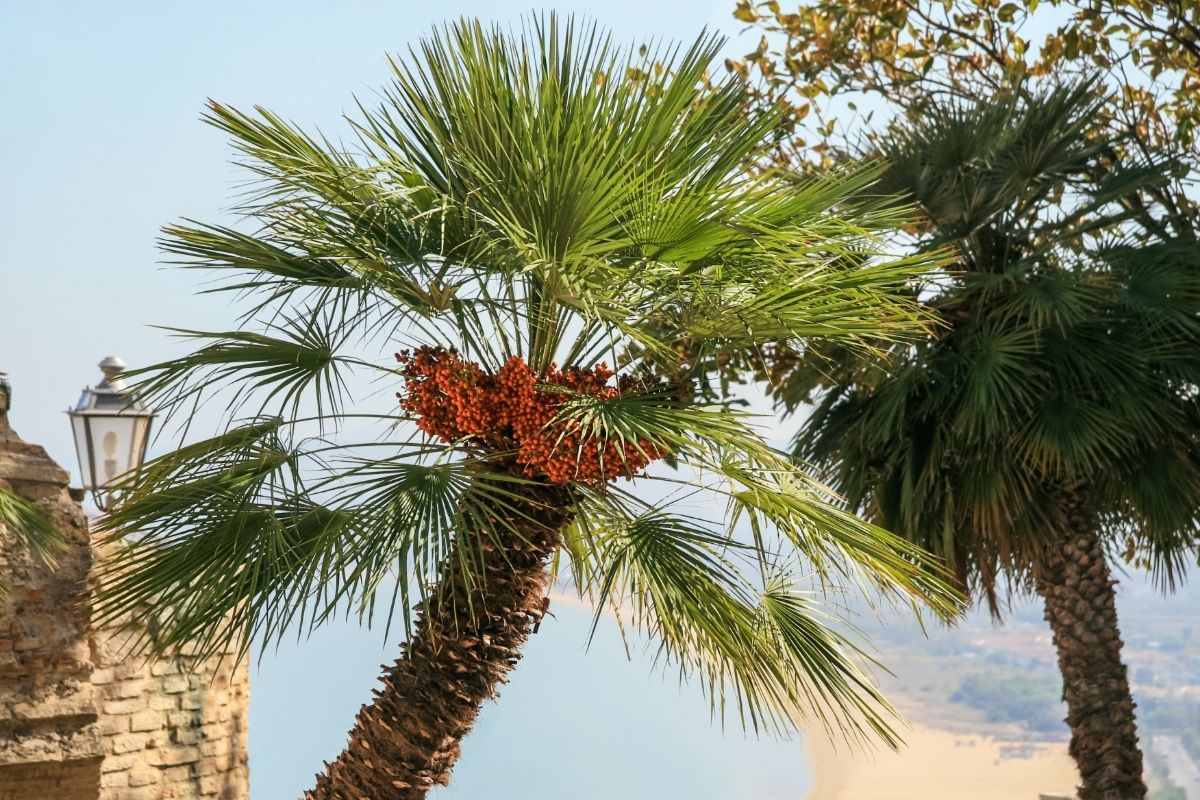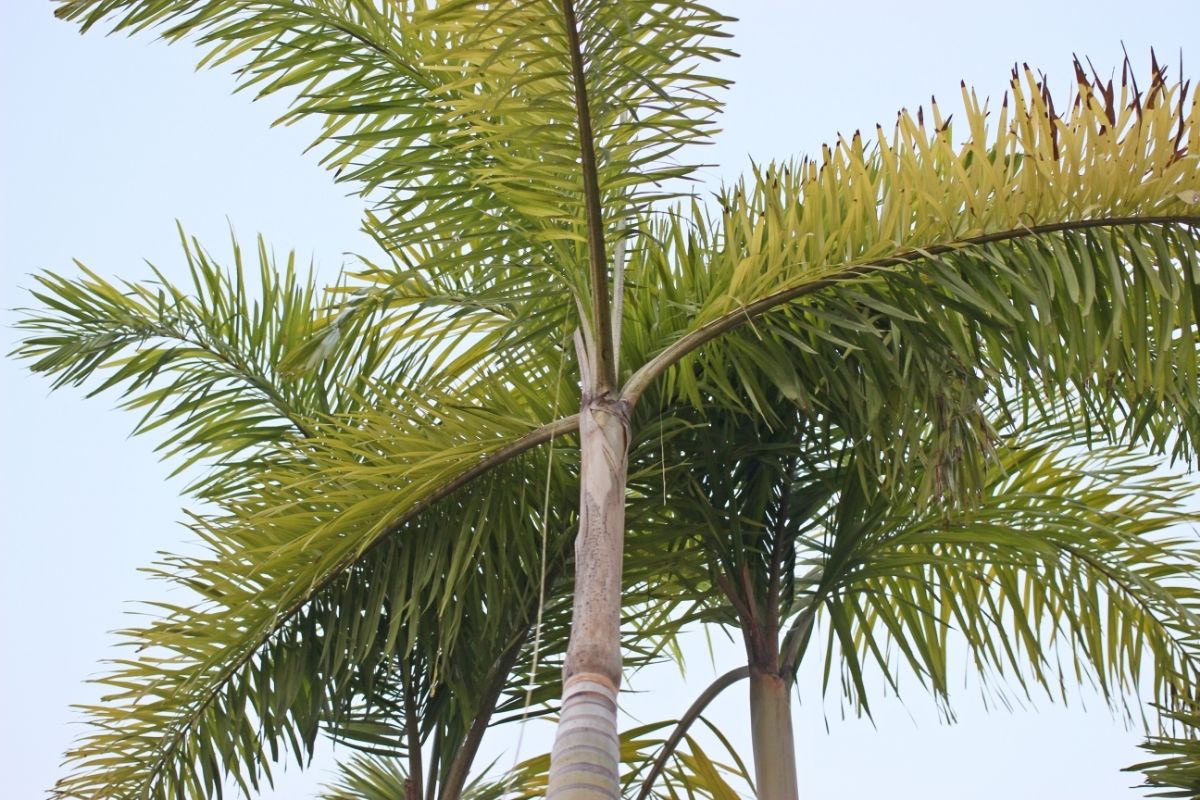How Tall do Palm Trees Grow?
How fast do palm trees grow? It’s likely that you already know about palms. Therefore, it shouldn’t be too difficult to determine the response to that question: “It depends on what kind of palm tree.”
It should come as no surprise that the growth rates of different species of trees are just as dramatically different as the sizes of the trees and the purposes for which you use them.

What is the Fastest Growing Palm Tree Type?
Palm trees are one of the most popular types of trees globally. They are known for their beauty and stately appearance. But how fast do they grow, and which is the fastest-growing palm tree?
There are many different types of palm trees, and each one has its growth rate. The fastest-growing palm tree is the Canary Island Date Palm. It can grow up to 10 feet (3 meters) per year!
Other fast-growing palm trees include the Washingtonia filifera (Desert Fan Palm) and the Syagrus romanzoffiana (Queen Palm). These two species can grow up to five or six feet (1.5-2 meters) per year. So, if you’re looking for a fast-growing palm tree, the Phoenix canariensis (Canary Island Date Palm ) is the way to go!
How Fast do Palm Trees Grow?
How fast do palm trees grow a year? That depends on the species. Some palm trees can grow three feet (0.9 meters) per year, while others may only grow one foot (0.3 meters) per year. The amount of sunlight and water the tree receives will affect its growth rate.
However, most palm trees will reach their full height within 10 to 20 years. So if you’re patient, you can enjoy the shade of a beautiful palm tree in your backyard in no time!
Unpacking the Different Types of Palm Trees and Their Growth Rates
In this section, we will examine the many species of palm trees and the different palm tree growth rates. The rate at which a particular species of palm tree grows is contingent on its species. This part of the article will discuss the most common palm species and their typical growth rate.
Lady Palm
These are scarce species of palm trees, and their growth and development need a significant amount of time. Therefore, if you contemplate planting this kind, you must first consider this time constraint.
In general, lady’s palms have a growth rate ranging from two to 10 inches (5.1 to 25.4 centimeters) per year. Even if the soil, temperature, and other favorable factors, hold.
If you bring a lady palm indoors to maintain it through the winter, it will take much longer to show growth indications. Even if you use a bright light source to speed up the process, it will still take some time for the plant to mature.
Fan Palm-Mexican
This tree, also known as the Mexican palm, expands by a steady four feet (1.2 meters) each year. If you plant it in the appropriate soil and give it a proper amount of water, this palm will have one of the palms’ quickest growth rates.
We can trace this plant back to some areas of Mexico. You may also come across several versions in California; if you plant the Fan palm in a site different from those described, the period for it to mature may be longer.
Windmill Palm
The Windmill palm has a slow growth rate of eight inches (20.3 centimeters) per year and is one of the palm trees on our list that can withstand the most adverse conditions. You won’t have any trouble fitting the plant into your home’s interior because of the relatively low height.
Additionally, these palms do well in various soil types and hardiness zones. Regarding the inside environment, the minimum hardiness zone is 4. In contrast, when it comes to the outside environment, the minimum hardiness zone is 8. Therefore, planting these trees in a lower location than the zones mentioned will perish over the following weeks.
Like all other types of palms, they cannot survive in cold temperatures and advance their growth at a glacial pace in such environments.
Queen and King Palm
Let’s look at the king palm growth rate and queen palm tree growth rate. Both the Queen and the King palm trees display an average growth rate of two feet per year. Even though you can plant them in any zone, they have a better chance of surviving and thriving in zones with a hardiness rating of 9 to 11.
When fully grown, they reach a height of 49 feet (15 meters). However, the plants need a significant amount of time to get to this stage of development—plan on planting King or Queen palms in a region that gets chilly. It would help if you kept them under protection until they become established.
It would be best if you also got ready to observe a significant slowdown in the typical growth pace throughout the winter months since it will occur.
Foxtails
A common variety of palm trees native to Australia, foxtails develop at a steady rate of one foot each year, making them a popular choice. The height of these trees is somewhere between 32.8 and 29.5 feet (10 and 9 meters). If you keep them inside, though, this risk may reduce. The secret is to give these palms plenty of room to grow into their great heights as they mature.
The ability of the Foxtail to perform admirably in brisk environments is unquestionably one of its most notable qualities. Similarly, it may also grow in places many classify as temperate and tropical. This is an exceptional quality, as most palm trees do not appear to possess it.
Be aware that if you intend to cultivate a foxtail in an indoor environment, the plant might not reach its full potential height of 30 feet (9.1 meters). In addition to this, you need to get your indoor setting ready to keep up with the plant’s growth rate. You won’t want to get rid of it after the tree reaches greater height.
Because of this, you should consider moving it outside during the earliest phases of its development. Growing this plant outside saves you time and energy, but it also minimizes the care and attention required. That is all we need to know about the foxtail palm growth rate.
European Palm
Even though these plants do not mature as rapidly as others, they continue to be popular due to their distinctive form and lovely structure. The European palm typically grows to 16 feet (4.9 meters) or less over its lifetime. Therefore, this can be the perfect option if you have a small yard and seek a palm tree with slow development.
When you cultivate European palms, you will observe that the young plants have an incredible growth rate in the early years of the plant’s life. During this period, kids will have an average annual growth of approximately 10 inches (25.4 centimeters). However, as time passes, the plants will begin to age, which, in turn, will affect the rate at which they grow.
The older varieties of these palms only grow a few inches each year, even when the climate and soil type are appropriate and even when the requirements for sunlight and irrigation are below expectations. As the plant grows, you will observe that it does not have any leaves. In most cases, they only develop sufficiently to produce one frond per year.
The European palm’s ability to withstand freezing temperatures is its most valuable trait. You can consider this quality quite exceptional because you won’t find this in any other palm trees. It is unlike other palms in that it can thrive in any climate. Even in colder regions, such as Texas, the plant will be able to survive and even thrive without any problems.
The hardiness zones can be cool. Because they are the perfect height, these are a fantastic choice for gardens that range from tiny to moderate in size. As a result of their height, they will not compete with your other trees for attention, but they will also cast the ideal amount of shade.
Carpentaria
There are only one species of these palms, and each year they grow to an astounding and highly stunning height of six feet (1.8 meters). They can reach heights of more than 100 feet (30.5 meters), which will be pretty lofty under favorable climatic conditions.
For this reason, you should only consider incorporating this palm into your landscape if there is sufficient room for it. If you do not keep the trees close to other fast-growing trees, they will grow to an even greater height on their own. Additionally, it would be best to refrain from planting rainforest plants in the surrounding area.
Even though it is native to the colder regions of Australia, the palm variety cannot survive the cold climate very well. As soon as these plants are under freezing temperatures, you will observe a discernible change in their growth rate.
Although it does exceptionally well in warm locations like Florida, its growth rate will be stunted in colder climates, leading it to dry out and wilt.

How do I Pick the Right Palm Tree for my Garden?
When selecting a palm tree for your property, there are five things to consider:
- The soil
- The size of the tree
- The temperature
- The amount of sunlight
- The amount of water
Suitable Soil for Palm Trees
The soil is the single most critical component for the growth of palm trees in a healthy manner. When purchasing a palm tree, it is essential to inquire about the amount of nutrients and water that the palm tree requires. The answer to this question will tell us what kind of soil is ideal for the growth of this palm tree. Fertilizer is yet another essential part of caring for palm trees.
Fertilizers explicitly for Palm Trees are necessary because many different varieties must grow in their unique environment. You can use both organic and inorganic fertilizers to improve the nutrient content of your soil if it is deficient.
When you buy fertilizer, check that it is high quality and has a formula that allows for a steady release of the nutrients. You should avoid purchasing inexpensive fertilizers since they will not last long during rain showers.
Palm Tree Size
The magnitude of the problem is critical. That tiny palm tree that you bought has the potential to grow into a huge tree very rapidly. Palm trees have the potential to grow to heights of up to fifty feet. If you plant it close, it has the potential to dominate the rest of your property and cause interference with the electricity lines.
Best Temperature for Palm Trees
You can find palm trees in warmer climates, including the tropics, deserts, coastal areas, and desert dunes. The defining characteristics of a tropical zone include high average temperatures, high relative humidity, and high annual precipitation. The low environment is conducive to growing a greater variety of palm tree species.
Even a little exposure to frost can be detrimental to the health of a palm tree because these plants thrive in warmer climates. Exposure to cold weather may make it more susceptible to pests and diseases.
Only a few palm species can withstand freezing temperatures, such as the Queen palm and the Canary Islands date palm. Most cold-hardy palms have a temperature threshold of fewer than 20 degrees Fahrenheit (-6.7 Celsius). This indicates that there are still only a few suitable locations for palm cultivation.
There aren’t many cold-hardy palms, but some of them, including the windmill palm and the needle palm, can survive in temperatures as low as 10 degrees Fahrenheit (-12.2 degrees Celsius).
Suppose you live in an area that experiences cold weather but would still like to have a gorgeous palm tree in your garden. In that case, you should first determine the temperature zone you live in. If you do this, you will have a better chance of finding a cold-hardy palm tree that will thrive in your region. Read our article and find out What Temperature Is Too Cold For Plants.
Sunlight
It is essential to consider the amount of sunshine available to your palm tree during the day. You must be aware that the solar tolerance of different palm tree species might vary considerably. Certain types thrive best in environments with shade rather than being under direct sunlight for the day.
Watering Palm Trees
In our minds, palm trees belong in dry, arid environments; nevertheless, you can only find them close to large quantities of permanently available water in the wild. Therefore, check to see that your palm gets adequate water if you plant it on your property to grow a palm tree there in the future.
Be ready to provide fresh water to a palm tree that recently moved to a new location while adjusting to its surroundings. As you can see, the requirements for palm trees change depending on the species.
Before you plant it, you need to make sure that you can fulfill its requirements and that it will have the opportunity to reach its full potential by thinking about the needs of the various types.
All About Palms is the title of an excellent book we have just discovered that targets novice readers. It contains information about planting, cultivating, and taking care of palm plants in a step-by-step format and magnificent photographs of more than two hundred distinct varieties of palm trees.
This book is ideal for the typical homeowner who has always been interested in palm plants.
The Life Cycle of Growing Palm Trees
The life cycle of palm trees consists of several distinct stages. In this section, we take a more in-depth look at them.
Germination
The period when your palm tree starts to establish its roots is germination. The process of germination for palm trees might vary from species to species. There are two different procedures here; The first one is decentralized expansion. During this stage, you will see that the plant produces tiny sprouts even before the roots begin to grow sprouts.
The nearby sprouting technique is the second method. In this case, the leaf emerges from the seed in a half-developed state. The plant’s root system develops later after its leaves have finished expanding from where they are now growing.
Vertical And Calliper Growth
In the life cycle of your plant, the step; “germination” is the one that presents the most challenge. As soon as a new leaf or shoot emerges from the plant, you may assume that it will continue to put on height throughout a subsequent couple of years. Another name for this kind of development is “vertical growth.”
At this point, you should arrange the leaves such that they point in an upward direction. The withered and rotten leaves will eventually fall off of the sturdy trunk as they continue to mature. You may anticipate that there will also be caliper growth as the process continues and the vertical expansion.
You will need to implement specific tactics for tissue widening if you want to maintain the height and stability of your plant. Age causes the tree to begin to spread, and the caliper, or circumference, of the tree will never stop increasing.
Blooming
The palm tree will start to bloom throughout the warm summer months as it ages and continues to mature. You can find flowers on palms, but they are not nearly as beautiful as the flowers you can see on other trees.
The blossoms of palm trees are tiny, and in most circumstances, you won’t even be able to view them from a close distance. These flowers are white in color and bloom in bunches. Also, they are pretty tiny.
Flowers do not appear on palm trees annually; in fact, some species may only bloom once in their whole lifetime. Still, others have blooms that bloom annually and take the form of fruits.
Fruition
The fruiting of palm trees is dependent on the presence of local pollinators. Like bees and bats, some are responsible for moving the pollen from one tree to another. Your blossoms will eventually morph into the form of the fruit if you do it this way.
The palm fruits tend to develop into tiny clusters similar to the blooms of the palm tree. After the fruits are ripe, you can immediately harvest them. Unfortunately, the animals in and around your neighborhood will inevitably consume them if you don’t.
Death
The fronds and calipers of palm trees begin to wither and fall off once the trees reach the end of their growth phase. If your palm trees are under a lot of stress, they may potentially die off more quickly.
They are also susceptible to dying as a result of natural disasters. After their passing, you will have the option of replacing them with a fresh tree or another palm and commencing the process once more.

Conclusion
To put it mildly, palm tree growing is breathtaking. As soon as you think of them, you return to a picture-perfect tropical scene. The tree towers over the landscape, imposing in stature, with broad leaves arranged in dense clusters.
Suppose you consider adding the plant to your garden. In that case, you must probably consider the typical rate at which plants of that species develop.
If you are looking for a fast-growing palm tree to fill a space in your garden, you must select carefully to ensure that you get one that can attain its full height quickly. The growth rate of palm trees varies significantly between the various species, so if you are looking for a fast-growing palm, you must choose carefully.
